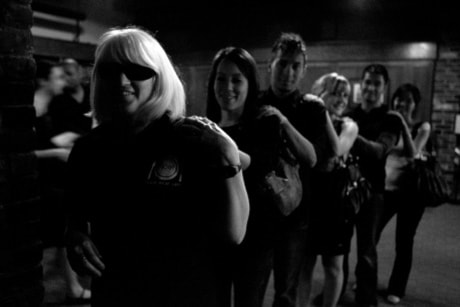TORONTO — It’s sounds just like how you would imagine a bustling restaurant would on a Friday night: a cacophony of clinking glasses, clattering dishes, shuffling chairs and animated chatter punctuated by occasional bursts of laughter.
The look of the place, however, is a different story.
Visitors of this downtown eatery will leave not knowing the decor of the dining area, what the food looked like, and in some cases, even what they ate.
It’s a feast for the senses at O.Noir — all except the eyes.
No burning candles on the tables, not even the LCD glow of a cellphone. Diners are enveloped in total, utter darkness.
The idea was pioneered by Jorge Spielmann, a blind Swiss pastor who would blindfold dinner guests visiting his home in an effort to mirror for his own mealtime experience.
He expanded his unique concept in 1999 with the opening of “Blindekuh” (“blind cow” in German), a Zurich-based restaurant where patrons eat their meals in the dark.
In addition to inviting sighted individuals to experience a world without vision, the project also employed individuals with vision loss as wait staff.
The concept has since spread to such international destinations as Australia, London and Los Angeles.
O.Noir owner and founder Moe Alameddine, who launched his first dining-in-the-dark eatery in Montreal three years ago, recently opened his latest in Toronto.
“It’s really a sensorial experience,” he said in an interview at the new restaurant, housed on the lower level of a hotel.
“People now, they eat with their eyes more.... You see a piece of cake ‘Wow,’ you say. ‘They’ve decorated the plate, it’s really nice.’ But you can eat the same thing without your eyes and it’s the same piece of cake.”
“We’re making a very nice plate, but we don’t have to spend half an hour to decorate the dessert plate,” he added.
“We’d rather spend on the quality and the herbs and the freshness so people can smell more, they can taste better.”
Diners select dishes from a set menu and also have the choice of picking a “surprise” option for one or all of their courses to truly put their taste buds to the test.
In addition to the creativity behind the concept, Alameddine said was also drawn to the idea of creating jobs for people with vision loss.
In a report released last month on the cost of vision loss in Canada commissioned by CNIB and the Canadian Ophthalmological Society, it was noted that the employment rate among working-age people with vision loss is only 32 per cent.
Among the 30 employees at O.Noir, Alameddine said 10 are blind.
Individuals with vision loss act as servers, also referred to as “guides.” They’re tasked not just with bringing food and drink to diners but with leading them in and out of one of O.Noir’s three darkened dining rooms, capable of seating a total of 100 people.
Patrons line up behind one another, placing their left hand on the left shoulder of the person in front of them with the guide leading the way into and out of the dining rooms.
Amidst the constant hum of chatter, servers can be heard calling out “Careful, careful,” in booming voices throughout the room as they move about, carrying dishes and assisting guests.
Server and guide Gavin Boylan had no previous experience prior to joining the O.Noir staff.
The 35-year-old had worked in construction and had been learning to be a plasterer.
Then he said he woke up one morning with big “floaties” or blockages clouding out his vision.
“I woke up on a Monday morning and thought ‘Was it a hangover? What’s going on?’ And then bam! My vision’s gone, that’s it,” said Boylan, a diabetic with blood behind his eyes.
He was unemployed for two years and couldn’t find work.
Boylan found out about O.Noir through CNIB and thought it was a neat concept.
After just a few weeks on the job, he is relishing the experience.
On The Net:
O.Noir: www.onoir.com
